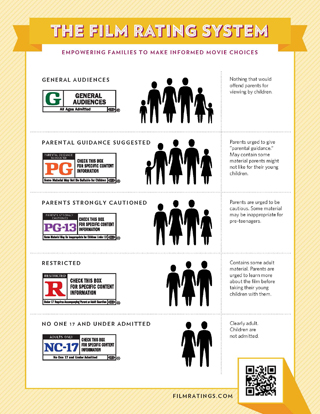The movie classification system is under attack in a spate of press commentaries, but I’ve got a simple fix. All those films that don’t like their ratings should withdraw from classification and play in cinemas “unrated.”

There is no requirement to be classified and some films go that route all the time.
It’s really an argument about Hollywood making more money by showing edgy films to increasingly younger audiences. There is no restriction for ages 18 and older.
Some pundits complain restrictive ratings result in fewer artistic awards and some media like newspapers restrict ads for films with restrictive ratings. Well, take that beef up with organizations that give awards and media outlets.
The current round of complaints take issue with the Classification and Rating Administration (CARA) that confers the familiar G, PG, PG-13, R and NC-17 ratings for audience suitability. (“Marketing to Moviegoers: Second Edition” addresses this topic including noteworthy experiences of specific films in Chapter 7/Distribution to Theaters). CARA is operated by major studio trade group the Motion Picture Assn. of America in cooperation with theaters.
“The MPAA should have changed its standards long ago, taking into account the context and tone of a movie instead of holding fast to rigid checklists,” Pulitzer Prize winning film critic Roger Ebert wrote in a “Wall Street Journal” opinion column. My reaction is what’s wrong with a check list…standards are good. If there are no standards, then it’s just chaos and abuse by industry.
Ebert also writes that since “grade school students now talk like truck drivers did in 1970” standards ought to be looser. That’s a clever phrase but a ridiculous argument that somehow coarse language should be acceptable. It’s certainly not a given that anything goes as accepted behavior for the entire U.S. Ebert does make some sense is suggesting ratings focus only on children/youth.
“Variety” also published a think piece that was more reasoned by Andrew Stewart, though I think that it misfires on several points. “There’s a longtime perception that exhibs won’t screen an NC-17 film and that advertisers deny such pics ad space,” the article says. Again, if that’s the problem, then take it up with theaters and advertising media.
One reason that ratings are under assault is that they have teeth, which means that they have credibility with audiences. There is a consistency that audiences—particularly parents—appreciate. It’s not an easy job given opinions on graphic content is subjective (to be clear–the ratings never comment on quality of a film, but rather suitability to ages under 18 years old.)
The rating gripes surfaced after Weinstein Co.’s “Blue Valentine” appealed an NC-17 rating…and won! An article in “The Hollywood Reporter” by Philiana Ng recounts that the Parents Television Council ripped CARA for a reversal giving “Blue Valentine” an R rating. A key scene is an oral sex act by two people without nudity, which stays in what will be an R-rated film.
In other instances, filmmakers say they get hints from CARA about what scenes should be deleted to get a less restrictive rating. So it’s their choice. Do they soften a film to make more money so it can play to a wider audience?
Some final points. CARA is voluntary and industry run. It has no government charter. Its main authority is credibility with audiences. There is no restriction on others setting up competing classification system (this is misunderstood) just as there is no restriction of filmmakers releasing movies unrated.
No films get banned. It’s just mostly a gripe about money, not artistic freedom.
Related content:
Leave a Reply